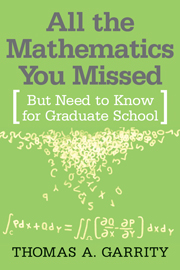Book contents
- Frontmatter
- Contents
- Preface
- On the Structure of Mathematics
- Brief Summaries of Topics
- 1 Linear Algebra
- 2 ∈ and δ Real Analysis
- 3 Calculus for Vector-Valued Functions
- 4 Point Set Topology
- 5 Classical Stokes' Theorems
- 6 Differential Forms and Stokes' Thm.
- 7 Curvature for Curves and Surfaces
- 8 Geometry
- 9 Complex Analysis
- 10 Countability and the Axiom of Choice
- 11 Algebra
- 12 Lebesgue Integration
- 13 Fourier Analysis
- 14 Differential Equations
- 15 Combinatorics and Probability
- 16 Algorithms
- A Equivalence Relations
- Bibliography
- Index
15 - Combinatorics and Probability
Published online by Cambridge University Press: 11 April 2011
- Frontmatter
- Contents
- Preface
- On the Structure of Mathematics
- Brief Summaries of Topics
- 1 Linear Algebra
- 2 ∈ and δ Real Analysis
- 3 Calculus for Vector-Valued Functions
- 4 Point Set Topology
- 5 Classical Stokes' Theorems
- 6 Differential Forms and Stokes' Thm.
- 7 Curvature for Curves and Surfaces
- 8 Geometry
- 9 Complex Analysis
- 10 Countability and the Axiom of Choice
- 11 Algebra
- 12 Lebesgue Integration
- 13 Fourier Analysis
- 14 Differential Equations
- 15 Combinatorics and Probability
- 16 Algorithms
- A Equivalence Relations
- Bibliography
- Index
Summary
Basic Goals: Cleverly Counting Large Finite Sets Central Limit Theorem
Beginning probability theory is basically the study of how to count large finite sets, or in other words, an application of combinatorics. Thus the first section of this chapter deals with basic combinatorics. The next three sections deal with the basics of probability theory. Unfortunately, counting will only take us so far in probability. If we want to see what happens as we, for example, play a game over and over again, methods of calculus become important. We concentrate on the Central Limit Theorem, which is where the famed Gauss-Bell curve appears. The proof of the Central Limit Theorem is full of clever estimates and algebraic tricks. We include this proof not only due to the importance of the Central Limit Theorem but also to show people that these types of estimates and tricks are sometimes needed in mathematics.
Counting
There are many ways to count. The most naive method, the one we learn as children, is simply to explicitly count the elements in a set, and this method is indeed the best one for small sets. Unfortunately, many sets are just too large for anyone to merely count the elements. Certainly in large part the fascination in card games such as poker and bridge is that while there are only a finite number of possible hands, the actual number is far too large for anyone to deal with directly, forcing the players to develop strategies and various heuristical devices.
- Type
- Chapter
- Information
- All the Mathematics You MissedBut Need to Know for Graduate School, pp. 285 - 306Publisher: Cambridge University PressPrint publication year: 2001



